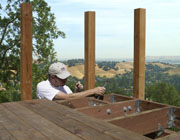This week’s blog was written by David Finkenbinder, P.E., who is a regional engineer working out of the Simpson Strong-Tie Ohio branch which services 24 states through the Northeast, Midwest, and Mid-Atlantic. He graduated from Penn State with a B.S. in Agricultural and Biological Engineering in 2004 and earned his M.S. in Civil Engineering with a focus on Structural Engineering from Virginia Tech in 2007. His master’s thesis investigated the splitting strength of bolted connections in solid-sawn lumber and structural composite lumber. Since joining Simpson Strong-Tie in 2007, David has shown a passion for deck safety and has served on committees developing prescriptive information and building code provisions for decks. Here is David’s post.
“Decks cause more injuries and loss of life than any other part of the home structure. Except for hurricanes and tornadoes, more injuries may be connected to deck failures than all other wood building components and loading cases combined.”
This quote, taken from Washington State University’s magazine article Making Decks Safer, underscores the critical importance of proper deck design, construction, and maintenance. An engineer who is encountering their first deck may be surprised that the deck design resources available are not as plentiful as he/she might have expected. The following resources can be helpful start:
For decks built to the IRC, the book Deck Construction Based on the 2009 International Residential Code provides a review of applicable code provisions and related commentary. The book gives background on important durability considerations such as flashing at points where the deck connects to an adjacent structure. The book also briefly discusses variations with IBC provisions, which can be significant for examples such as minimum guard height and live loads.
The American Wood Council (AWC) has several tools available in addition to using the NDS for wood member and connection design. Calculators for evaluating simple span joists and single fastener connections are available in both web-based and mobile app format. Technical Report 12, which was the topic of our May blog post, provides the ability to design connections with a gap between members, or with members having a hollow cross section. AWC’s DCA6 – Prescriptive Residential Wood Deck Construction Guide presents information for common deck details and a commentary covering important considerations for alternate designs. While the guide is helpful, please note that it is limited in scope to single level residential decks and does not address wind or seismic design.
Researchers at Virginia Tech and Washington State University conducted laboratory testing and published information to help in several common topics needing attention. An article in the May 2008 issue of Structure Magazine featured test performance of ledger-to-band joist connections using bolts or lag screws – this information has since been adopted into the IRC.
For lateral design there has been some uncertainty regarding lateral loads that can be generated by occupants, and if the magnitude of such is significant in comparison with wind and seismic forces calculated from ASCE 7. Tests were conducted of occupants performing several types of movement on a deck floor configuration. Separate articles summarizing results for each load type were published in the Summer 2013 issue of Wood Design Focus, along with a fourth article on the lateral performance of IRC ledger attachments (online copies of the articles courtesy of Professional Deck Builder magazine: Wind Loads; Seismic Loads; Occupant Loads).
Our January 2013 post, Corrosion: The Issues, Code Requirements, Research, and Solutions, touches on the corrosion considerations that are significant for most projects as well.
Have you found any other resources that have been helpful in your designs? Let us know by posting a comment.



